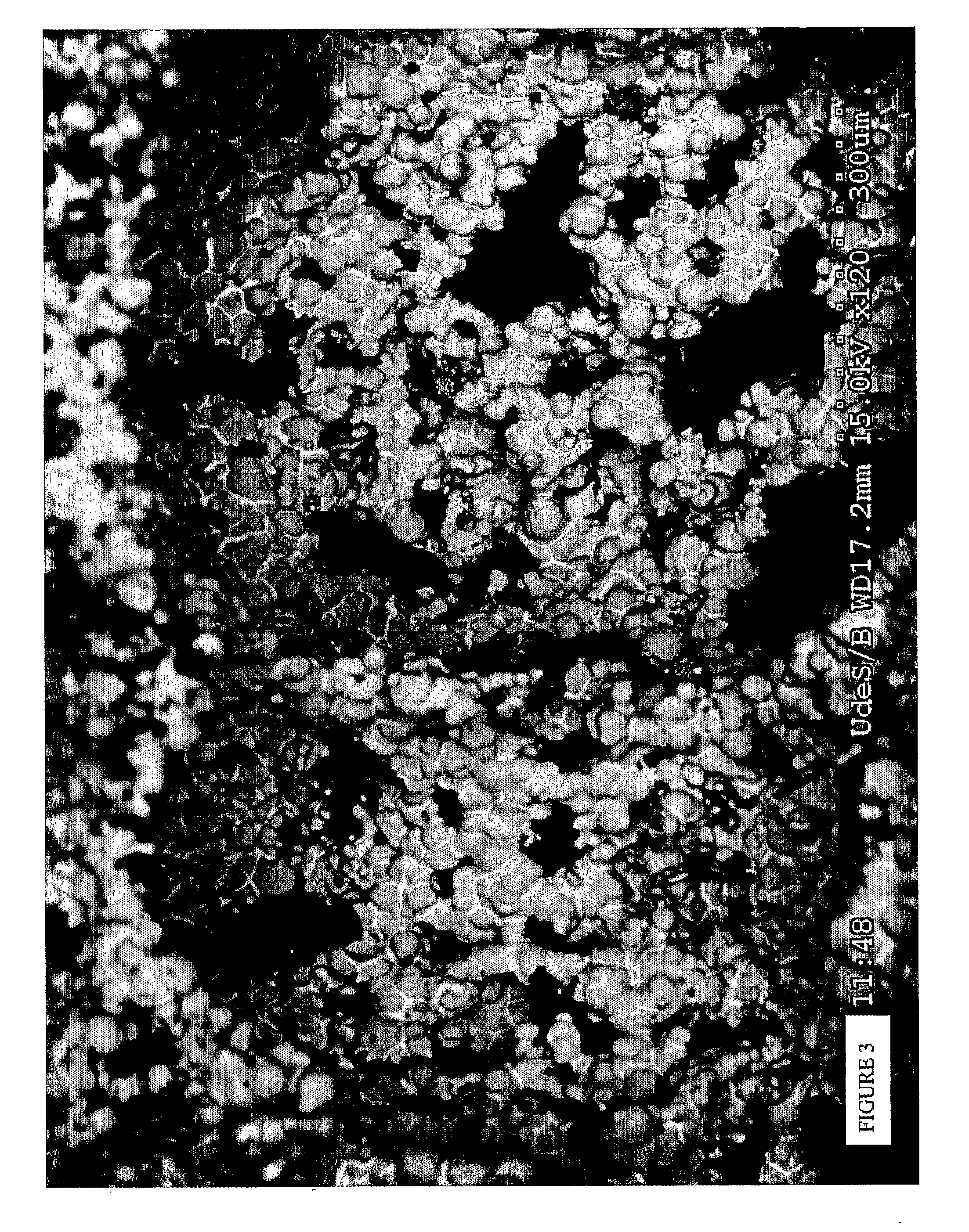Open cell porous material and method for producing same
a porous material and open cell technology, applied in the field of porous materials, can solve the problems of unsuitable brazing and poor mechanical properties of porous materials, and achieve the effects of improving the flowability of mixtures, minimizing segregation and dusting, and improving mechanical strength of foamed structures
- Summary
- Abstract
- Description
- Claims
- Application Information
AI Technical Summary
Benefits of technology
Problems solved by technology
Method used
Image
Examples
example 1
[0104]Open cell porous metal samples, with copper (Cu) as the based material, were produced with the formulation presented in Table 1 and in accordance with the present invention. The different constituents were dry-mixed together until the mixture became homogeneous. After mixing, the mixture was poured into a mould and foamed at 110° C. in air for 2 hours. After foaming, the material was submitted to the decomposition of the binder in a tube furnace at 650° C. for 4 hours in a dry air stream. Finally, the specimens were brazed in an Ar-25% H2 atmosphere for 1 hour at 780° C.
TABLE 1Formulation used for the production of the Cu based foamInorganic brazingInorganicBindingFoamingalloy particlesparticlesagentagentSilver based alloyCu powderPhenolicP-toluene sulfonyl(72 wt. % Ag & 28resinhydrazidewt. % Cu)11.7 wt. %58.3 wt. %29.5 wt. %0.5 wt. %
[0105]Open cell porous copper (Cu) samples were produced with the formulation presented in Table 2 and in accordance with the procedure described...
example 2
[0108]Open cell porous metal samples, with iron (Fe) as the based material, were produced with the formulation presented in Table 3 and in accordance with the present invention. The different constituents were dry-mixed together until the mixture became homogeneous. After mixing, the mixture was poured into a mould and foamed at 110° C. in air for 2 hours. After foaming, the material was submitted to the decomposition of the binder in a tube furnace at 400° C. for 4 hours in a dry air stream. Finally, the specimens were brazed in an Ar-25% H2 atmosphere for 30 minutes at 895° C.
TABLE 3Formulation used for the production of the Fe based foamInorganic brazingInorganicBindingFoamingalloy particlesparticlesagentagentSilver based alloyFe powderPhenolicP-toluene sulfonyl(56 wt. % Ag & 42resinhydrazidewt. % Cu & 2 wt. % Ni)15 wt. %55 wt. %29.5 wt. %0.5 wt. %
[0109]Open cell porous iron (Fe) samples were produced with the formulation presented in Table 4 and in accordance with the procedure ...
example 3
[0112]Open cell porous metal samples, with nickel (Ni) as the based material, were produced with the formulation presented in Table 5 and in accordance with the present invention. The different constituents were dry-mixed together until the mixture became homogeneous. After mixing, the mixture was poured into a mould and foamed at 110° C. in air for 2 hours. After foaming, the material was submitted to the decomposition of the binder in a tube furnace at 400° C. for 4 hours in a dry air stream. Finally, the specimens were brazed in an Ar-25% H2 atmosphere for 1 hour at 780° C.
TABLE 5Formulation used for the production of the Ni based foamInorganic brazingInorganicBindingFoamingalloy particlesparticlesagentagentSilver based alloyNi powderPhenolicP-toluene sulfonyl(72 wt. % Ag & 28resinhydrazidewt. % Cu)11.7 wt. %58.3 wt. %29.5 wt. %0.5 wt. %
[0113]Open cell porous nickel (Ni) samples were produced with the formulation presented in Table 6 and in accordance with the procedure described...
PUM
| Property | Measurement | Unit |
|---|---|---|
| density | aaaaa | aaaaa |
| thickness | aaaaa | aaaaa |
| thickness | aaaaa | aaaaa |
Abstract
Description
Claims
Application Information
 Login to View More
Login to View More - R&D
- Intellectual Property
- Life Sciences
- Materials
- Tech Scout
- Unparalleled Data Quality
- Higher Quality Content
- 60% Fewer Hallucinations
Browse by: Latest US Patents, China's latest patents, Technical Efficacy Thesaurus, Application Domain, Technology Topic, Popular Technical Reports.
© 2025 PatSnap. All rights reserved.Legal|Privacy policy|Modern Slavery Act Transparency Statement|Sitemap|About US| Contact US: help@patsnap.com



